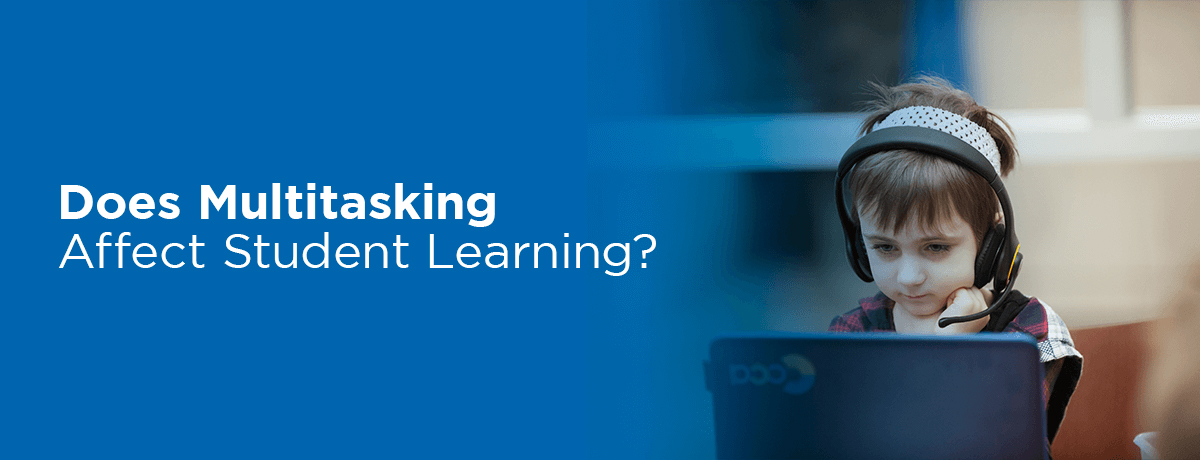2025-2026 School Year Enrollment Now Open. Click Here
2025-2026 School Year Enrollment Now Open. Click Here

We’ve all experienced the science of multitasking, like receiving a phone call in the middle of an important assignment. It’s not always easy. Media multitasking, or using multiple digital platforms at the same time, makes it hard for students to get focused and pay attention. When media multitasking, other stimuli like a text message or movie scene demand attention, and students are likely to miss crucial concepts. Here, you’ll learn the impact of multitasking on learning and how it changes the way kids learn. You’ll also gain insight into some tips on how to help your student avoid multitasking while learning, like practicing guided meditation or removing distracting technologies.
In America, adults spend 42% of their waking hours in front of a screen, whether that be their smartphone, television, computer, tablet, or another device. Media multitasking involves using multiple platforms simultaneously. For students, this can look like watching television in the background, text messaging friends, or listening to podcasts while working on assignments. It can even include having multiple unrelated tabs open, like email or a social media site.
With so many new technologies surfacing in the past decades, media multitasking is more prevalent than ever. Take smartphones, for example. More than 50% of American children aged 11 or older have a smartphone. This is different from older generations who were raised without this technology. When you consider other growing technologies like smart televisions and voice-operated devices, it’s easy to understand why students are drawn to using multiple devices while completing assignments.
Multitasking changes the way kids learn. When students engage in two or more activities — like completing homework and watching television — their performance begins to decrease, specifically information retention and productivity. That’s because multitasking increases their chances of making mistakes on their assignments. Plus, they’re more likely to miss information and less likely to retain the information they do learn.
In a study of working adults, multitasking decreased productivity by 40% and cost workers 30 seconds to refocus their attention after a distraction. It’s possible that the negative effects on student achievement are even greater because they’re still developing the performance skills necessary to be successful both in academics and later in life. Overall, 96.2% of students engage in some sort of media multitasking while studying or working on assignments.
Luckily, there are ways you can help your student learn how to work on their assignments without multitasking. Keep in mind these changes won’t happen overnight. Start building better working habits to get your student focused using the following tips:
Students won’t want to stop a habit if they don’t know it’s harming their productivity. Step one is exploring the effects of multitasking with your student. Aside from reviewing statistics, you can take this opportunity to challenge them — ask for one hour where they work without any distractions, like their phone or television, and see how it changes their output. Odds are, they’re going to face some obstacles, like the urge to check their technologies. However, they may also see greater and faster results as well as a higher level of satisfaction when completing the assignment.
Next, set your student up for success by clearing any distractions. It’s imperative to get your student involved in this step, or else they may feel targeted and begin to protest the idea. Some arrangements you can make to clear distractions from your student’s work area include:
Distractions are unique to your student. Not all of these examples are what your student needs. Communicate with them and see where their distractions lay, then brainstorm ideas on how to limit those distractions.
Meditation is beneficial for many reasons. In an academic setting, meditation can help students be more productive, reach goals more easily, and find it easier to prioritize one assignment. Some students find meditation easier when doing a guided practice, where a professional walks through techniques like:
Instead of disciplining your student for multitasking, reward them during the moments where they focus on a single task or complete their assignment on time. The reward system you instill depends on your student’s age — tweens won’t get excited about stickers, and high school students won’t feel motivated by a token economy system.
Breaking it down by age group, some ways you can create a reward system include:
Commonwealth Charter Academy (CCA) is a cyber charter school that serves students throughout the Commonwealth of Pennsylvania. We offer year-round open enrollment, where students can enjoy the flexibility to begin their education with us whenever is most convenient for them.
Our goal at CCA is for graduates to become the leaders of tomorrow, contributing to society’s betterment. A large part of how we make this happen is by giving our students an engaging curriculum personalized to their unique learning styles. Students can’t succeed if their tasks aren’t interesting enough to make them forget about their potential distractions like cellphones or televisions. At CCA, you can trust students will receive an exceptional education and learn foundational skills — like avoiding media multitasking — that will help them throughout their time with us and their future.
Learn more about what we can do for your student and family by contacting us online today.
2025-2026 School Year Enrollment Now Open. Click Here